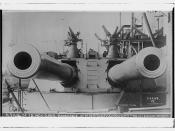How Guns Work
A gun is a weapon that uses the force of an explosive propellant to project a missile.
Guns or firearms are classified by the diameter of the barrel opening. This is known as the calibre of the gun. Anything with a calibre up to and including .60 calibre(0.6 inches) is known as a firearm.
The precise origin of the gun is unknown, although they were in use by the early 14th century and were common place in Europe by mid-century. These early guns were nothing more than large calibre cylinders of wrought iron or cast bronze, closed at one end and loaded by placing gunpowder and projectile in the muzzle, or open end.
Nowadays firearms are a little more sophisticated.
However, the physics behind all guns remain the same. Weapons such as cannons, shotguns and rifles, work on the basic idea of conservation of momentum and the change in energy from potential to kinetic.
When the trigger is pulled the hammer hits the firing pin. The firing pin then hits the primer which causes the powder to burn hence producing lots of gases. This causes the volume behind the bullet to fill with extremely high pressure gas. The gas pushes on every surface it encounters, including the bullet in front of it and the base of the gun barrel behind it. The increase in pressure caused by the gases causes the bullet to be forced into the barrel hence causing the bullet to come out the muzzle at very high speeds. Once the bullet is fired, it remains in motion from its momentum. The momentum will carry the bullet until it strikes an object or gravity pulls the bullet towards the earth.
Firearms change potential chemical energy into kinetic energy in the actual firing of the gun.

![Gun Shops, Krupps [i.e., Krupp], Essen (LOC)](https://s.writework.com/uploads/17/171466/gun-shops-krupps-e-krupp-essen-loc-thumb.jpg)

Guns
Are the scores of this essay wrong? This essay was very informative and I enjoyed reading it.
0 out of 0 people found this comment useful.